The best time to visit India is between October and March, when you’ll find pleasant temperatures and clear skies across most regions. Northern areas like Delhi and Rajasthan offer comfortable sightseeing weather, while southern destinations like Kerala and Goa boast perfect beach conditions. October through November brings vibrant festivals like Diwali, though expect peak crowds and prices. December to February delivers ideal conditions for everything from tiger safaris to temple tours. Each region’s unique seasonal patterns expose distinct travel experiences.
Key Takeaways
- October to March offers the most pleasant temperatures nationwide, with clear skies and minimal rainfall for comfortable sightseeing.
- December-January brings peak tourist crowds and highest prices, requiring advance bookings of at least 3 months for popular destinations.
- March-April provides moderate crowds and lower rates during colorful festivals like Holi, before summer heat intensifies.
- June to September brings monsoon rains to most regions, offering significant hotel discounts but potentially challenging travel conditions.
- Northern mountains are best visited June-September, while southern states remain comfortable October-March with minimal weather disruptions.
Weather & Seasons Across Indian Regions
The weather in India follows distinct seasonal patterns that vary dramatically across its vast geography. You’ll experience five traditional seasons, though modern meteorologists recognize four main ones: winter, summer, monsoon, and post-monsoon periods.
When you’re planning your trip, remember that monsoon onset variations profoundly impact different regions. Being the seventh largest country, India’s expansive landscapes create diverse microclimates across its territory. While coastal areas maintain steady temperatures between 25-35°C year-round, they face weather dependent infrastructure issues during heavy rains and cyclones. The northern plains swing between extremes, with summers exceeding 45°C and winters dipping below 0°C.
The southwest monsoon drenches most of India from June to September, bringing 75% of annual rainfall. You’ll find relief from intense heat in hill stations like Ooty and Munnar, where temperatures stay pleasant at 15-25°C. The Himalayas offer cool summers but become snow-bound in winter, while the Thar Desert remains scorching with minimal rainfall throughout the year.
Peak Tourist Months & Festival Highlights
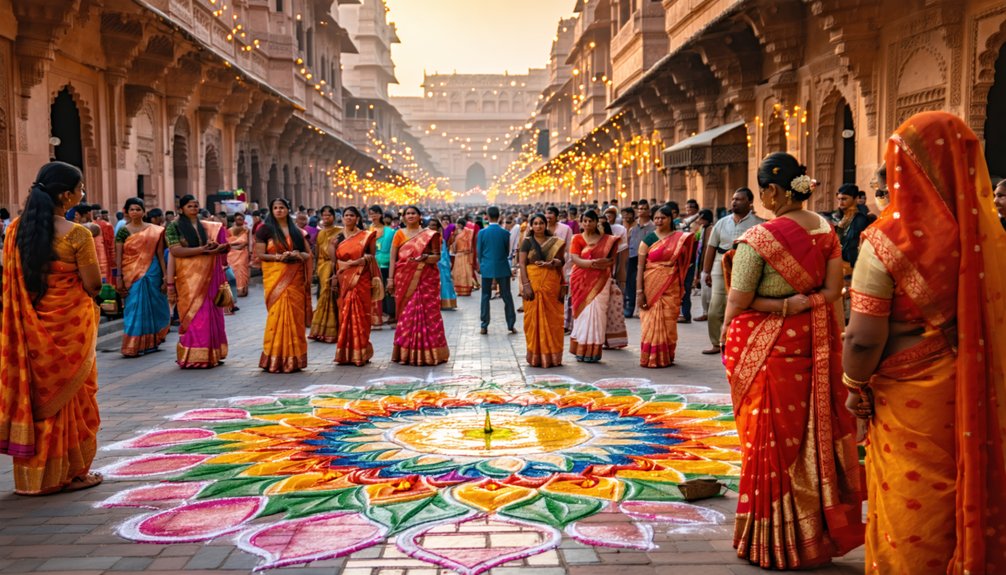
You’ll find India’s tourism peaks during December-January, when international arrivals surge to their highest levels and hotel rates climb 30-50% due to the holiday rush. Major festivals like Diwali in October-November and Holi in March markedly impact tourist patterns, drawing crowds to specific regions during these cultural celebrations. If you’re seeking better deals and fewer crowds, consider visiting during shoulder seasons like February-March or October-November, when you can still experience festivals while enjoying more moderate pricing and accessibility. The favorable conditions in February make it particularly appealing as fog and mist clear in northern regions, creating optimal sightseeing conditions across the country.
December-January Holiday Rush
During December and January, India’s tourism hits its peak as domestic and international travelers flood popular destinations across the country. You’ll encounter massive crowds at iconic sites like the Taj Mahal, which sees over 20,000 daily visitors, while Goa’s beaches become packed with New Year revelers. Advance planning is crucial since booking 3 months ahead is recommended for the best accommodations and transportation options.
Expect significant booking challenges and price surges during this period. Hotels in prime locations like Jaipur and Agra fill up months in advance, while flight prices jump 40-60% compared to autumn rates. You’ll face dense morning fog in North India that can disrupt travel plans, though South India maintains pleasant temperatures between 25-32°C. Consider alternative destinations like Kerala or Karnataka’s less crowded beaches, or explore wildlife parks like Ranthambore where reduced capacity actually improves your chances of spotting animals.
Major Festival Tourist Impact
Beyond winter’s peak season, India’s festival calendar shapes distinct tourist patterns throughout the year. You’ll find October-November particularly impactful, with Diwali and Pushkar Camel Fair driving hotel availability to its limits and triggering 20-30% price fluctuations in popular destinations.
March brings the vibrant Holi celebrations, offering a more balanced travel experience with moderate crowds and slightly lower rates than peak season. While August-September’s monsoon festivals like Ganesh Chaturthi create localized surges in places like Mumbai, you’ll find significant discounts elsewhere due to the rains. December to March offers optimal conditions for exploring temple sites and tiger safaris. Consider these festival timings when planning your trip – book well ahead for October-November visits, take advantage of shoulder season rates during Holi, or explore monsoon festival destinations when hotel prices drop by up to 30%.
Off-Peak Festival Benefits
While peak winter tourism dominates India’s travel calendar, the country’s vibrant off-peak festivals offer unique advantages for savvy travelers. You’ll find substantial accommodation pricing benefits during shoulder and monsoon seasons, with hotels offering up to 40% discounts compared to peak winter rates.
The off-season presents pristine cultural immersion opportunities without overwhelming crowds. During monsoon months, you can experience intimate celebrations like Kerala’s Onam boat races or Rajasthan’s Teej Festival. Ayurvedic treatments are particularly beneficial during the June-August monsoon season. Shoulder seasons bring iconic events like Holi in March and Diwali in October-November, when cities burst with authentic local energy rather than tourist crowds.
Pre-monsoon festivals showcase spectacular events like Thrissur Pooram’s elephant processions, while post-monsoon celebrations feature Maharashtra’s Ganesh Chaturthi and Bengal’s elaborate Durga Puja – all with reduced tourism pressure.
Planning Your Visit by Geographic Zone
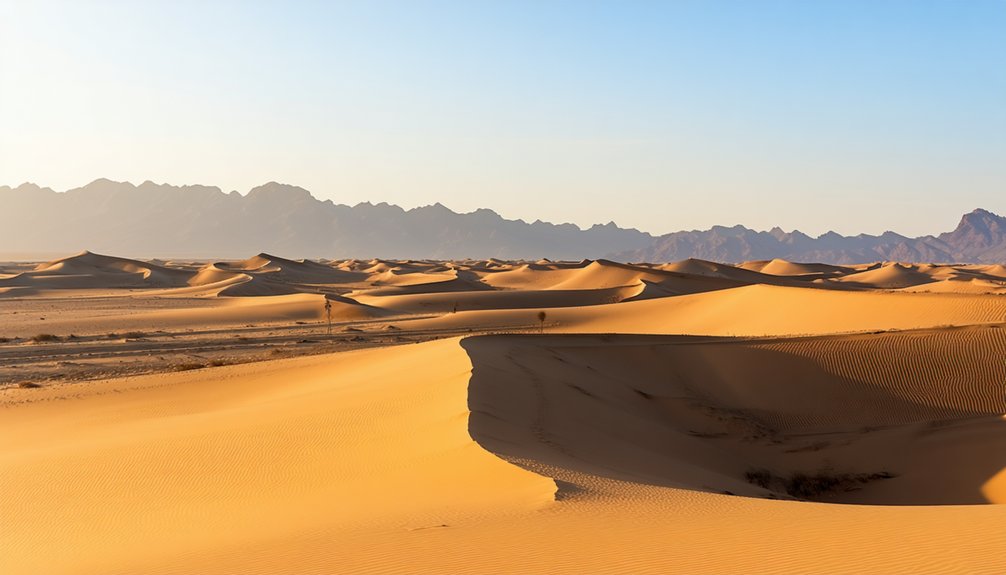
Since India’s vast territory spans multiple climate zones, planning your visit requires careful consideration of each region’s distinct seasons. You’ll find the northern Himalayas best from June to September in Ladakh, while March to May suits Himachal Pradesh. The southern peninsula shines between October and March, perfect for exploring regional cuisine highlights in Kerala and Tamil Nadu.
Central India beckons from October through March, when mild temperatures make fort-hopping and local handicraft shopping in Rajasthan delightful. The eastern regions, including Kolkata and Sikkim, offer ideal conditions from November to February, though spring brings spectacular mountain blooms. Western India’s sweet spot falls between November and February, perfect for coastal adventures.
Avoid the scorching summer months (April-June) in central plains, where temperatures soar above 45°C, and skip the heavy monsoons (July-September) in most regions unless you’re seeking lush landscapes at the expense of accessibility. Wildlife enthusiasts should plan their visits during the warm winter months, as animals are more frequently spotted near water sources.
Choosing the Right Time for Specific Activities
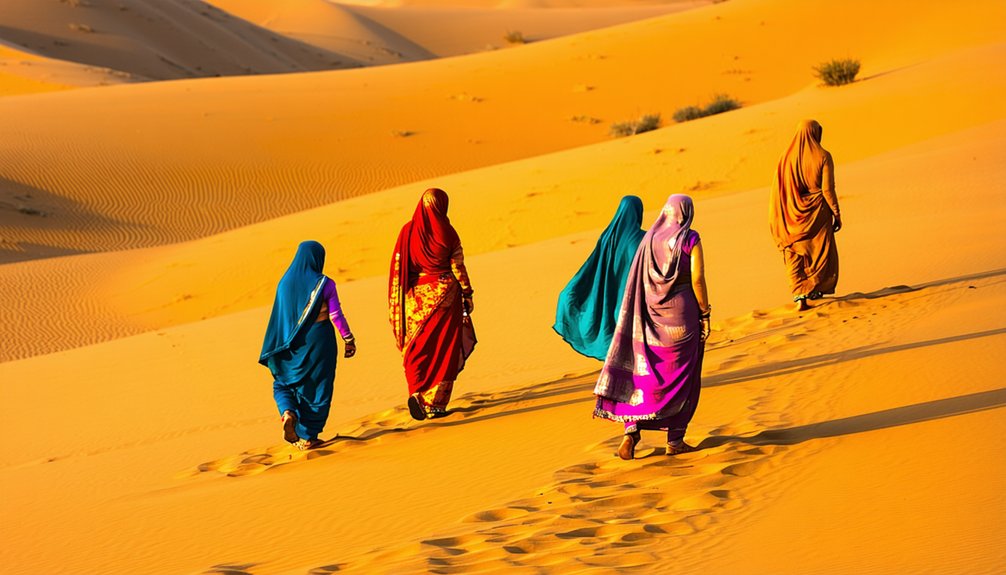
For ideal wildlife encounters, you’ll find April brings peak tiger sightings at Ranthambhore while the October-March window offers excellent all-around safari conditions across India’s national parks. The mild temperatures and dry conditions between November and February create perfect opportunities for birdwatching enthusiasts, especially at renowned locations like Bharatpur Bird Sanctuary. If you’re seeking specific species, consider timing your visit around natural patterns – rhinos are best spotted in Kaziranga from April to June, while elephants and deer are most visible in Kerala’s Periyar Sanctuary during early summer months. For cultural experiences in northern India, the mild, sunny winter from November to February provides comfortable sightseeing conditions at iconic destinations.
Wildlife Safari Peak Times
To experience India’s incredible wildlife at its finest, you’ll want to plan your safari between October and June during the dry season. While most parks face closures during monsoon (July-September), popular wildlife viewing seasons vary by region and species.
| Season | Temperature | Wildlife Activity |
|---|---|---|
| Summer (Mar-Jun) | Above 104°F | High tiger activity near water |
| Winter (Dec-Feb) | 70s°F days | Good for bird watching |
| Post-monsoon (Oct-Nov) | Moderate | Active predator sightings |
| Pre-monsoon (May-Jun) | Very hot | Peak wildlife at waterholes |
For specific encounters, target April-June in central India for tigers, April-May in Gir for Asiatic lions, and November-March in Ladakh for snow leopards. Southern parks like Periyar offer year-round access, with ideal elephant viewing in March-April. December visitors should plan well ahead as the opportunity to see wild tigers at Christmas makes this a particularly busy period.
Temple Hopping Weather Tips
Planning a temple-hopping adventure through India requires careful timing to maximize both comfort and spiritual experience. The ideal window spans October through March, when temperatures remain moderate and rainfall minimal. You’ll find temples most accessible during early mornings (4-6 AM) or evenings, aligning with traditional prayer times while avoiding midday heat. Early morning visits are enhanced by the tranquil atmosphere as birds chirp and a pleasant breeze blows.
Consider regional weather variations carefully. While North India stays dry from October-March, South India faces northeast monsoons during October-December. Tamil Nadu temples are best visited November-February, while Rajasthan’s sacred sites shine October-March. Take monsoon precautions in Kerala during June-September, but embrace the mystical atmosphere of mist-shrouded temples in hill stations during this period. For festivals, plan around major celebrations like Diwali (October/November) when temples burst with energy and devotional fervor.
Month-by-Month Travel Guide
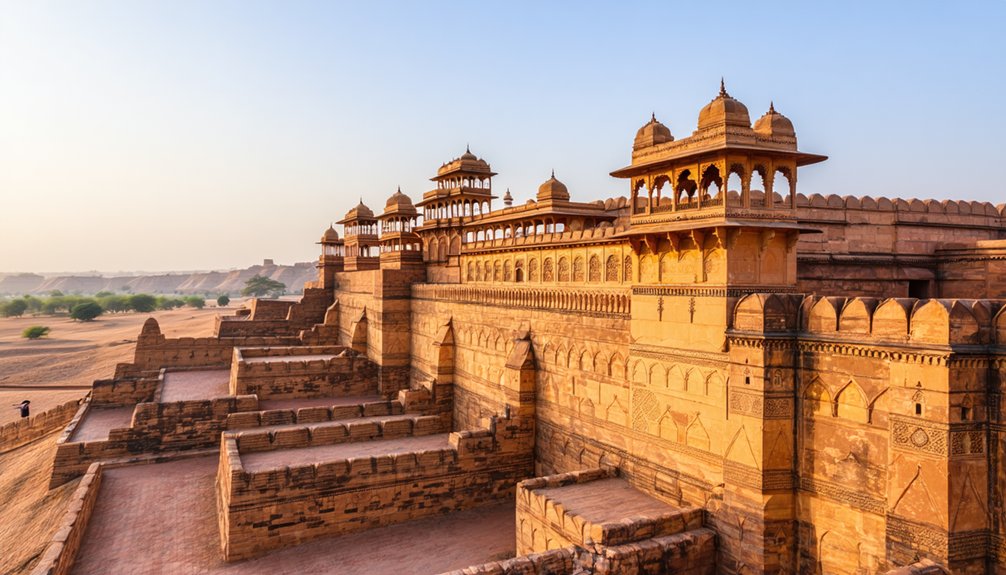
Understanding India’s diverse climate patterns is essential for planning your visit effectively. January kicks off peak travel season with cold nights in the north, while southern states offer warm retreats. You’ll find foggy mornings in Delhi but perfect conditions for Himalayan treks.
February brings pleasant nationwide temperatures of 20-25°C, making it ideal for exploring. Don’t miss the vibrant Jaisalmer Desert Festival, but book early due to regional popularity. March offers the colorful Holi celebrations before temperatures climb, while wildlife viewing reaches its peak in central India.
April and May see temperatures soar to 45°C in northern regions, though you’ll find budget-friendly rates during this off-season period. The thermal dam effect from the Himalayas contributes to these extreme summer temperatures. Wildlife reserves offer excellent animal sightings at water holes, but plan activities for early mornings or evenings. By June, the monsoon arrives in Kerala and northeastern states, while Ladakh opens its doors with comfortable 15-20°C temperatures perfect for mountain adventures.
Essential Tips for Seasonal Travel
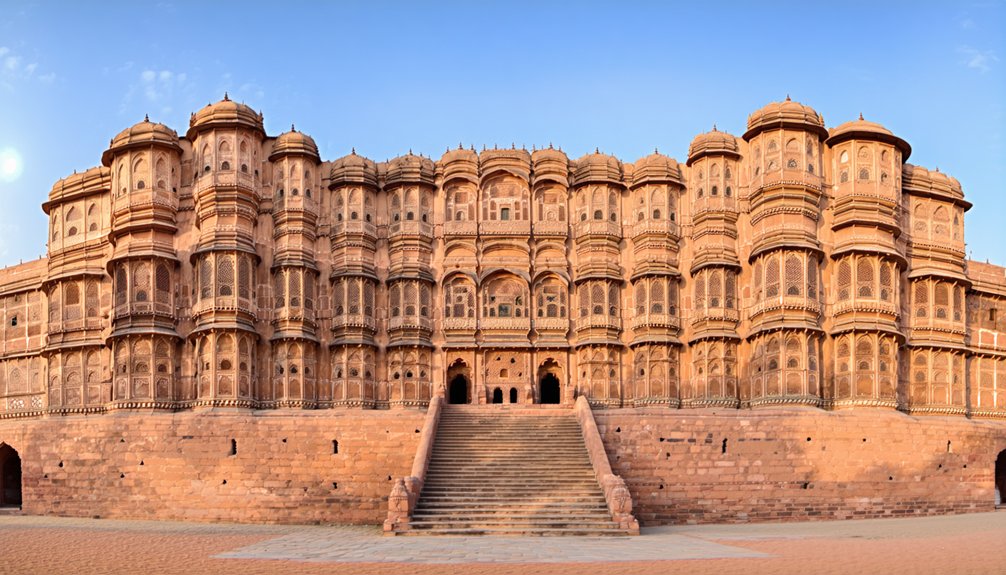
Whether you’re dreaming of the snow-capped Himalayas or sun-soaked beaches in Goa, successful seasonal travel in India depends on careful timing and preparation. Consider your regional destinations carefully – northern India shines from November to February, while southern states peak from December to March.
When budgeting for seasonal pricing, factor in 20-30% higher costs during peak seasons and religious holidays, especially in tourist hotspots like Rajasthan. You’ll find better deals during shoulder seasons in October and April, with equally pleasant weather and fewer crowds.
Pack strategically for India’s diverse climates. You’ll need lightweight cotton for scorching summers, layers for chilly winter mornings, and reliable waterproof gear for monsoons. The southwest monsoon season typically brings heavy rainfall from June to September, making these months less ideal for travel. Don’t forget high-SPF sunscreen and DEET-based repellents for tropical regions.
Book accommodation and transportation well in advance, particularly during major festivals like Diwali and Holi. For popular UNESCO sites, investing in certified guides with pre-booked tickets will help you bypass lengthy queues.





